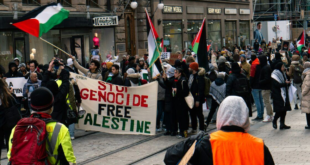 KERBALA, Iraq (Reuters) – Hundreds of thousands of pilgrims poured into Iraq’s holy city of Kerbala on Saturday, defying bomb attacks across the country to attend a rite that has become an annual show of strength for the Shi’ite majority.
KERBALA, Iraq (Reuters) – Hundreds of thousands of pilgrims poured into Iraq’s holy city of Kerbala on Saturday, defying bomb attacks across the country to attend a rite that has become an annual show of strength for the Shi’ite majority.
Many of the pilgrims have walked for days in temperatures of up to 50 degrees Celsius (122 Fahrenheit) to mark the birth of Imam Mohammed al-Mehdi, a Messiah-like figure Shi’ites believe vanished centuries ago and will return to bring peace on earth.
A bomb in a parked car struck pilgrims walking in Baghdad early on Saturday, killing six and wounding 10, police said.
Late on Friday, a van packed with explosives was detonated at a bus station where pilgrims were assembling in Balad, a Shi’ite town in a mainly Sunni area north of Baghdad, killing nine people and wounding 40, according to police.
On Thursday, a female suicide bomber killed 19 pilgrims and wounded 75 when she blew herself up amid a group making the journey on foot near Iskandariya south of Baghdad.
Authorities said they had managed to avoid bloodshed in Kerbala itself after last year’s pilgrimage was marked by gun battles between Shi’ite factions and Iraqi security forces.
“Thank God the situation is under control. We haven’t observed any security violations. People are happy and cooperating with security forces,” said Captain Abdullah Muhammad of the Iraqi army in Kerbala.
“This year we haven’t seen the pilgrims holding pictures of clerics or shouting against the government like last year.”
Najim Muhammad al-Lami, 43, said he had walked for six days with his wife and two children from the southern city of Basra.
“We come every year. Last year my son was wounded by a bullet during the pilgrimage, but I insisted on coming again anyway. This year the situation is more secure and organized.”
DEMONSTRATIONS OF STRENGTH
The event is one of several annual pilgrimage rites that have evolved into massive demonstrations of strength for the Shi’ite majority since the fall of dictator Saddam Hussein, a Sunni Arab who restricted Shi’ite religious practice.
The pilgrimages are targets for attacks despite the sharp decline in violence in the country.
Authorities have banned people from carrying weapons and chanting sectarian slogans.
Iraqi security forces, backed by helicopters and hundreds of snipers on rooftops, say they will search pilgrims and use sniffer dogs to help find explosives. U.S. forces have virtually no troops stationed in the Kerbala area.
Police in fatigues and red berets checked identity cards and searched the faithful entering the golden-domed Imam Hussein mosque, strung with brightly colored lights. Nearby, makeshift clinics were set up in tents. Some pilgrims donated blood.
Many of the worst attacks of Iraq’s war have taken place during pilgrimages. Bombs killed 171 people during a pilgrimage in 2004, heralding Iraq’s looming sectarian conflict.
Rumors of a bomb on a Baghdad bridge during a pilgrimage in 2005 caused a stampede in which more than 1,000 people died, the deadliest incident of the war. During the last major pilgrimage in July, three female suicide bombers killed nearly 30 people.
Outrage among Shi’ite groups after the violence in last year’s pilgrimage prompted anti-American cleric Moqtada al-Sadr to declare a ceasefire of his Mehdi Army militia, which U.S. forces say has helped contribute to a reduction of violence.
Last week Sadr formed a new social wing of his movement and said most Mehdi Army fighters would disarm.
New armed cells would be trained to attack U.S. bases if the Americans decide to remain in Iraq for the long term, Sadr’s spokesman Salah al-Ubaidi said in a statement on Saturday.
“The future of these cells and their resistance action depends on the American decision: either to implement a withdrawal timetable or to establish long-term bases.”
 Eurasia Press & News
Eurasia Press & News

